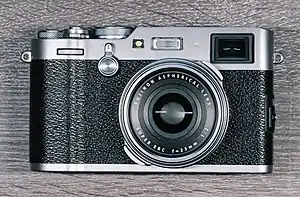Fujifilm
Fujifilm Holdings Corporation (富士フイルムホールディングス株式会社, Fuji-fuirumu Hōrudingusu kabushiki gaisha), trading as Fujifilm (富士フイルム, Fuji-fuirumu), or simply Fuji, is a Japanese multinational conglomerate headquartered in Tokyo, Japan, operating in the realms of photography, optics, office and medical electronics,[2][3][4] biotechnology,[5][6] and chemicals.[7][8]
The Fujifilm logo used since 2006 | |
 Midtown West, the current global headquarters of Fujifilm in Tokyo | |
Native name | 富士フイルムホールディングス株式会社 |
|---|---|
Romanized name | Fuji-fuirumu Hōrudingusu kabushiki gaisha |
| Type | Public KK |
| Industry | |
| Founded | January 20, 1934 |
| Headquarters | Midtown West, Tokyo Midtown Akasaka, Minato, Tokyo, Japan |
Area served | Worldwide |
Key people |
|
| Products |
|
| Revenue | |
| Total assets | |
Number of employees | 73,906 (2019)[1] |
| Website | holdings.fujifilm.com |
The offerings from the company that started as a manufacturer of photographic films, which it still produces, include: document solutions, medical imaging and diagnostics equipment, cosmetics, pharmaceutical drugs, regenerative medicine, stem cells, biologics manufacturing, magnetic tape data storage, optical films for flat-panel displays, optical devices, photocopiers and printers, digital cameras, color films, color paper, photofinishing and graphic arts equipment and materials.[2][4][9][10][11]
Fujifilm is part of the Sumitomo Mitsui Financial Group financial conglomerate (keiretsu).
History
20th century
Fuji Photo Film Co., Ltd. was established in 1934 as a subsidiary of Daicel with the aim of producing photographic films. Over the following 10 years, the company produced photographic films, motion-picture films and X-ray films. In the 1940s, Fuji Photo entered the optical glasses, lenses and equipment markets. After the Second World War, Fuji Photo diversified, penetrating the medical (X-ray diagnosis), printing, electronic imaging and magnetic materials fields. In 1962, Fuji Photo and UK-based Rank Xerox Limited (now Xerox Limited) launched Fuji Xerox Co., Ltd. through a joint venture.
From the mid-1950s, Fuji Photo accelerated the establishment of overseas sales bases. In the 1980s, Fuji Photo expanded its production and other bases overseas, stepping up the pace of its business globalization. Meanwhile, Fuji Photo developed digital technologies for its photo-related, medical and printing businesses. As a result, it invented computed radiography (CR), which solved a number of issues of traditional radiography, resulting a decrease of radiation exposure to both technician and patient. Fujifilm's systems were marketed and sold under the FCR brand.[12]
Like its rival Eastman Kodak which dominated in the US, Fuji Photo enjoyed a longtime near-monopoly on camera film in Japan. By becoming one of the title sponsors of the 1984 Los Angeles Olympics (an opportunity that Kodak passed on), offering cheaper camera film, and establishing a film factory in the US, Fuji gained considerable market share there, while Kodak had little success in penetrating Japan. In 1994 the vice president Juntarō Suzuki announced that the company would halt paying sōkaiya, a type of protection racket bribe, to Yakuza. In retaliation of this he was murdered in front of his home by them.[13] In May 1995, Kodak filed a petition with the US Commerce Department under section 301 of the Commerce Act arguing that its poor performance in the Japanese market was a direct result of unfair practices adopted by Fuji. The complaint was lodged by the US with the World Trade Organization. On January 30, 1998, the WTO announced a "sweeping rejection of Kodak's complaints" about the film market in Japan.[14][15]
21st century
The new millennium witnessed the rapid spread of digital technology, and demand for photographic films plunged in line with the growing popularity of digital cameras. In response, Fuji Photo implemented management reforms aimed at drastic transformation of its business structures. Even as early as the 1980s, the company had foreseen the switch from film to digital, so "it developed a three-pronged strategy: to squeeze as much money out of the film business as possible, to prepare for the switch to digital and to develop new business lines." While both film manufacturers recognized this fundamental change, Fuji Photo adapted to this shift much more successfully[14] than Eastman Kodak (which filed for bankruptcy in January 2012). Fuji Photo's diversification efforts also succeeded while Kodak's had failed; furthermore Kodak built up a large but barely profitable digital camera business that was undone quickly by smartphone cameras.[14]
In March 2006, Noritsu and Fuji announced a strategic alliance for Noritsu to manufacture all of Fuji's photofinishing hardware, such as minilabs. Each company produces its own software for the minilabs.[16]
On September 19, 2006, Fujifilm announced plans to establish a holding company, Fujifilm Holdings Corp. Fujifilm and Fuji Xerox would become subsidiaries of the holding company. A representative of the company reconfirmed its commitment to film, which accounts for 3% of sales.[17]
On January 31, 2018, Fujifilm announced that it would acquire a 50.1% controlling stake in Xerox for US$6.1 billion, which will be amalgamated into its existing Fuji Xerox business.[18][19][20] The deal was subsequently dropped after intervention by activist investors Carl Icahn and Darwin Deason.[21] In late 2019, Fujifilm announced its acquisition of Xerox's 25% stake in the 57-year-old joint venture, Fuji Xerox.[22]
In December 2019, Fujifilm acquired Hitachi's diagnostic imaging business for US$1.63 billion.[3]
Amid the 2020 COVID-19 pandemic, one of Fujifilm Toyama Chemical drugs, i.e. favipiravir, an antiviral commercially named Avigan, is being considered as a possible treatment for the virus,[8][23] after having been approved by China, Russia, and Indonesia authorities by June 2020.
In June 2020, Fujifilm announced a US$928 million investment to a Denmark-based biologics production facility, which it acquired from Biogen a year earlier for around US$890 million, to double the manufacturing capacity.[24] A tape cartridge using strontium ferrite that could store up to 400TB was showcased by Fujifilm in the late same month.[25]
Subsidiaries
Fuji Xerox was a joint venture between Fujifilm and Xerox Corporation of North America. After the dissolution of their partnership in 2019, Fujifilm made it a wholly owned subsidiary. In January 2020, the corporate name change was announced, from Fuji Xerox to Fujifilm Business Innovation Corporation, effective on April 1, 2021.[26]
Fujifilm bought Sericol Ltd., a UK-based printing ink company specializing in screen, narrow web, and digital print technologies in March 2005.[27]
Fujifilm de México is a Fujifilm subsidiary in Mexico that sells Fujifilm products since 1934 and has been recognized as one of The Best Mexican Companies (Las Mejores Empresas Mexicanas) from 2012 to 2015, a recognition promoted by Banamex, Deloitte México and Tecnológico de Monterrey.[28]
Fujifilm is active in pharmaceutical products and contract manufacturing[29] through its subsidiaries including Fujifilm Toyama Chemical, Fujifilm Diosynth Biotechnologies, etc.
As of July 2020, the Fujifilm Group has two operating companies, which encompass more than 300 subsidiaries in total, and three "shared services companies" under the umbrella.[30] The group structure and a list of some Fujifilm subsidiaries are the following:[31]
- FUJIFILM Holdings Corporation
- FUJIFILM Corporation
- Fujifilm Imaging Systems
- Fuji Color Photo Center[32]
- Fujifilm Medical
- Fujifilm Pharma
- Fujifilm RI Pharma
- Fujifilm Toyama Chemical
- Fujifilm Dimatix
- Fujifilm Diosynth Biotechnologies
- FUJIFILM Cellular Dynamics
- Fujifilm Photo Manufacturing
- Fujifilm Fine Chemicals
- Fujifilm Electronics Materials
- Fujifilm Engineering
- Fujifilm Optics
- Fujifilm Opto Materials
- Fujifilm Global Graphic Systems
- Fujifilm Computer Systems
- Fujifilm Software
- Fujifilm Techno Services
- Fujifilm Techno Products
- Fujifilm Business Supply
- Fujifilm Digital Press
- Fujifilm Media Crest
- Fujifilm Sonosite, Inc.
- Fujifilm Shizuoka
- Fujifilm Kyushu
- Fujifilm Logistics
- Fujifilm VisualSonics
- Fujifilm Imaging Systems
- Fuji Xerox
- Fuji Xerox Printing Systems Sales
- Fuji Xerox Information Systems
- Fuji Xerox System Service
- Fuji Xerox Interfield
- Fuji Xerox Advanced Technologies
- Fuji Xerox Manufacturing
- Fuji Xerox Service Creative
- Fuji Xerox Service Link
- Fuji Xerox Learning Institute
- FUJIFILM Business Expert Corporation
- FUJIFILM Systems Corporation
- FUJIFILM Intellectual Property Research Co., Ltd.
- FUJIFILM Corporation
Products
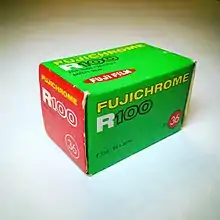
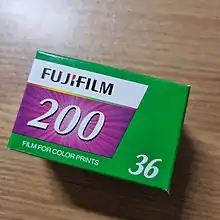



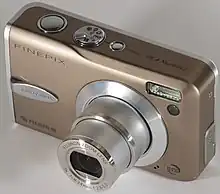

Photographic film
- Fujifilm photographic films
- Motion picture film stock. (Discontinued 2013.)
- Fujichrome color reversal (slide) films.
- Velvia: one of the most saturated and fine-grained slide films, valued by nature and landscape photographers.
- Provia: a slide film giving more natural colors than Velvia
- Astia: a fined grained, low contrast slide film often used for studio or portrait applications
- Sensia: a low-contrast consumer slide film; the current emulsion is considered to be identical or near-identical to Astia in the professional line.[33][34]
- Fortia: slide film, featuring extremely vivid color rendering suitable for flower photography and other high-saturation applications (for Japanese market).
- Fujicolor color negative (print) films
- Fujicolor Pro 160S, 160C, 400H, and 800Z (formerly NPS, NPC, NPH, and NPZ): professional films with different levels of contrast
- Reala: the first film to use the fourth cyan-sensitive layer, currently sold under Superia Reala name
- Superia: intended for snapshots
- Press: Cut from the same emulsion stock as Superia, but cold stored and sold as a professional film.
- Fuji Neopan Professional black & white negative film. Neopan 400 and 1600 were designed to use the same developing times, and can be developed in the same tank/machine and developer combination simultaneously. ACROS and SS do not share this feature.
- Neopan SS: ISO 100 film, most common and least expensive Neopan film
- Neopan ACROS: ISO 100 film, finer grain than SS but usually more expensive
- Neopan Presto: ISO 400 speed film
- Neopan Super Presto: ISO 1600 for low-light shooting or fast action
- Instax instant film packs for Fujifilm's line of instant film cameras
Cameras and lenses
- Fujifilm GFX series cameras (medium format sensor)
- Fujifilm X series cameras (all current models APS-C; some past models featured a 2/3" sensor)
- The Fujifilm FinePix series of digital cameras including:
- Nikon F-mount compatible digital SLRs like the FinePix S5 Pro
- Compact cameras like the FinePix F-series and FinePix Z-Series, Fujifilm X100 and X100S
- Waterproof and shockproof FinePix XP-Series digital cameras
- The Clear Shot series of 35mm compact cameras
- Instax series of instant camera
- Fotorama series of instant camera
- Various rangefinder cameras, and older Fujica film cameras
- Professional film cameras such as the GA645,[35] GW670, GW690, GF670, GF670W and Fuji GX680 6x8cm medium format cameras
- Fujinon camera lenses and binoculars: including the most widely used television lenses in the world
Other
- Photographic paper
- Inkjet printer paper
- Magnetic media, including audiotape (also includes the Axia brand) until 2009, videotape, Magnetic tape data storage and floppy disks
- Optical media, such as DVDs and CDs, mostly produced by Ritek and Taiyo Yuden; some by Philips
- Flash memory
- Fujifilm X-Trans series of CMOS image sensors.
- Photostimulable Phosphor Plate - X-ray film.
- Base material for LCD displays
- Recording Media
- Microfilm
- Minilab equipments, announced in 2006 a global alliance with Noritsu Koki, together holding a market share of more than 80% of the global market
- Digital X-Ray, digital mammography and computed radiography devices
- Synapse Radiology PACS
- Synapse Cardiovascular PACS
- Synapse RIS
- Ultrasound systems
- Endoscopy
- Specialty Chemicals
- Biologics contract manufacturing and development
- Biomaterials
- Regenerative medicine
- Cosmetics (ASTALIFT series, Nanolift series)
 Fujifilm FinePix XP130 yellow camera
Fujifilm FinePix XP130 yellow camera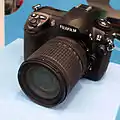 Fujifilm S5 Pro
Fujifilm S5 Pro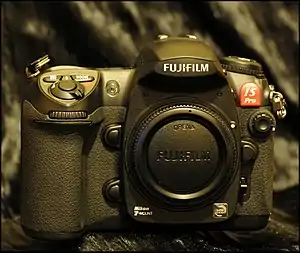 Fujifilm IS Pro
Fujifilm IS Pro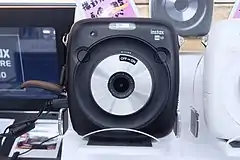 Instant camera Fujifilm Instax SQUARE SQ10
Instant camera Fujifilm Instax SQUARE SQ10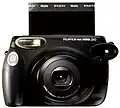 Instant camera Fujifilm Instax 210
Instant camera Fujifilm Instax 210 Fujifilm FinePix S5500
Fujifilm FinePix S5500 Fujifilm FinePix S700
Fujifilm FinePix S700 Fujinon GF 32–64 mm F4 R LM WR lens
Fujinon GF 32–64 mm F4 R LM WR lens Fujifilm products in a film vending machine in Japan
Fujifilm products in a film vending machine in Japan Fujifilm Fujica STX-1N
Fujifilm Fujica STX-1N Fujifilm GFX 50S
Fujifilm GFX 50S_2017-04-26_(148).jpg.webp) A Fujifilm television lens
A Fujifilm television lens
See also
References
- "Fujifilm Financial Information 2019" (PDF). Retrieved 2020-12-02.
- "Medical Systems | Fujifilm Global". www.fujifilm.com. Retrieved 2021-02-21.
- "Fujifilm Acquires Hitachi Diagnostic Imaging Business". www.diagnosticimaging.com. 19 December 2019. Retrieved 2020-07-17.
- "Home FUJI XEROX CO.,LTD". www.fujixerox.com. Retrieved 2021-02-21.
- "Fujifilm socks $2B into new U.S. site as its global CDMO ambitions take shape". Fierce Pharma. 7 January 2021. Retrieved 2021-02-21.
- "Eyeing growth in regenerative medicine, Fujifilm spends $800M on two new members of its CDMO business". Endpoints News. Retrieved 2020-11-17.
- "Specialty Chemicals | Fujifilm [United States]". www.fujifilm.com. Retrieved 2021-02-21.
- Matsuoka, Katsumori (April 13, 2020). "Fujifilm tests favipiravir as COVID-19 treatment". C&EN. Retrieved April 15, 2020.
- Tomisawa, Ayai (2014-10-30). "Fujifilm cautious on Avigan profitability, eyes Ebola spread". Reuters. Retrieved 2021-02-21.
- Coughlin, Tom. "Digital Storage Projections For 2021, Part 1". Forbes. Retrieved 2021-03-31.
- "Document Solutions | Business Activities | Fujifilm Group's Value Creation | Investor Relations | FUJIFILM Holdings". ir.fujifilm.com. Retrieved 2021-03-31.
- Mattoon, John S.; Smith, Carin (January 2004). "Breakthroughs in Radiography: Computed Radiography". Compendium. 26 (1).
Introduced in the 1980s by Fujifilm Medical Systems, computed radiography (CR) ...
- http://www.japanesestudies.org.uk/reviews/Maruko.html Sōkaiya and Japanese Corporations], Eiko Maruko, Electronic Journal of Contemporary Japanese Studies, 25 June 2002
- "Technological change: The last Kodak moment?". The Economist. 2012-01-14. Retrieved 2014-02-07.
- "The Kodak - Fuji Rivalry |Business Strategy Case Studies|Business Strategy Articles". Icmrindia.org. 2013-11-14. Retrieved 2014-02-07.
- "Do Fuji and Noritsu Look Alike? Reason: They Really Are (Well, Almost)". Imaginginfo.com. Archived from the original on 7 April 2008. Retrieved 24 May 2019.
- Fuji Photo to diversify, shift to holding company system | The Japan Times Online
- "Fujifilm acquires Xerox for $6.1 billion". Ars Technica. Retrieved 2018-02-01.
- Shirkey, Alec (2018-01-31). "A Giant Is Born: Fujifilm Deal Allows Xerox To Make Inroads Into Asia-Pacific Print Market, Bolster Next-Gen R&D Efforts". CRN. Retrieved 2018-02-01.
- Shirkey, Alec (2018-01-31). "Fujifilm Buys Controlling Stake In Xerox, Creating An $18 Billion Printer Industry Behemoth". CRN. Retrieved 2018-02-01.
- "Xerox drops Fujifilm deal in settlement with Carl Icahn". CNBC. 14 May 2018. Retrieved 2018-05-15.
- "Xerox exits Fujifilm venture with $2.3 billion stake sale to Japan partner". Reuters. 2019-11-05. Retrieved 2020-07-17.
- "Fujifilm pairs with Dr. Reddy's, Global Response Aid to make COVID-19 drug Avigan". Fierce Pharma. July 2020. Retrieved 2020-07-17.
- "Fujifilm commits $928m to expand biologics facility in Denmark". Pharmaceutical Technology. 2020-06-10. Retrieved 2020-07-17.
- Mellor, Chris (2020-06-29). "Fujifilm points to 400TB tape cartridge on the horizon". Blocks and Files. Retrieved 2020-07-17.
- "Fuji Xerox Announces Corporate Name Change to FUJIFILM Business Innovation Corp. | FUJI XEROX CO.,LTD". www.fujixerox.com. Retrieved 2020-08-01.
- Fuji Photo Film Acquires Sericol Group of the United Kingdom Archived 2011-06-18 at the Wayback Machine
- "Empresas Reconocidas - Las Mejores Empresas Mexicanas". Mejoresempresasmexicanas.com. Archived from the original on 2016-02-06. Retrieved 2016-06-13.
- "Fujifilm launches the Bio CDMO Division". Fujifilm Global. Retrieved 2020-07-17.
- "Group Companies | FUJIFILM Holdings". holdings.fujifilm.com. Retrieved 2020-07-17.
- "Consolidated Subsidiaries of FUJIFILM Holdings Corporation:Japan | FUJIFILM Holdings". holdings.fujifilm.com. Retrieved 2020-07-17.
- "フジカラー フォトセンター ||| 会社概要 |||". Archived from the original on 2019-09-05. Retrieved 2017-09-08.
- Everything but the kitchen sink
- "Fuji Astia 100F Slide Film Review". Nathangriffin.com. Retrieved 2014-02-07.
- "Awards:GOOD DESIGN | 富士フイルムのデザイン". design.fujifilm.com. Retrieved 2015-12-29.
External links
- Official website (Consumer)
- Official website (Corporate)
- "Company history books (Shashi)". Shashi Interest Group. April 2016. Wiki collection of bibliographic works on Fujifilm
